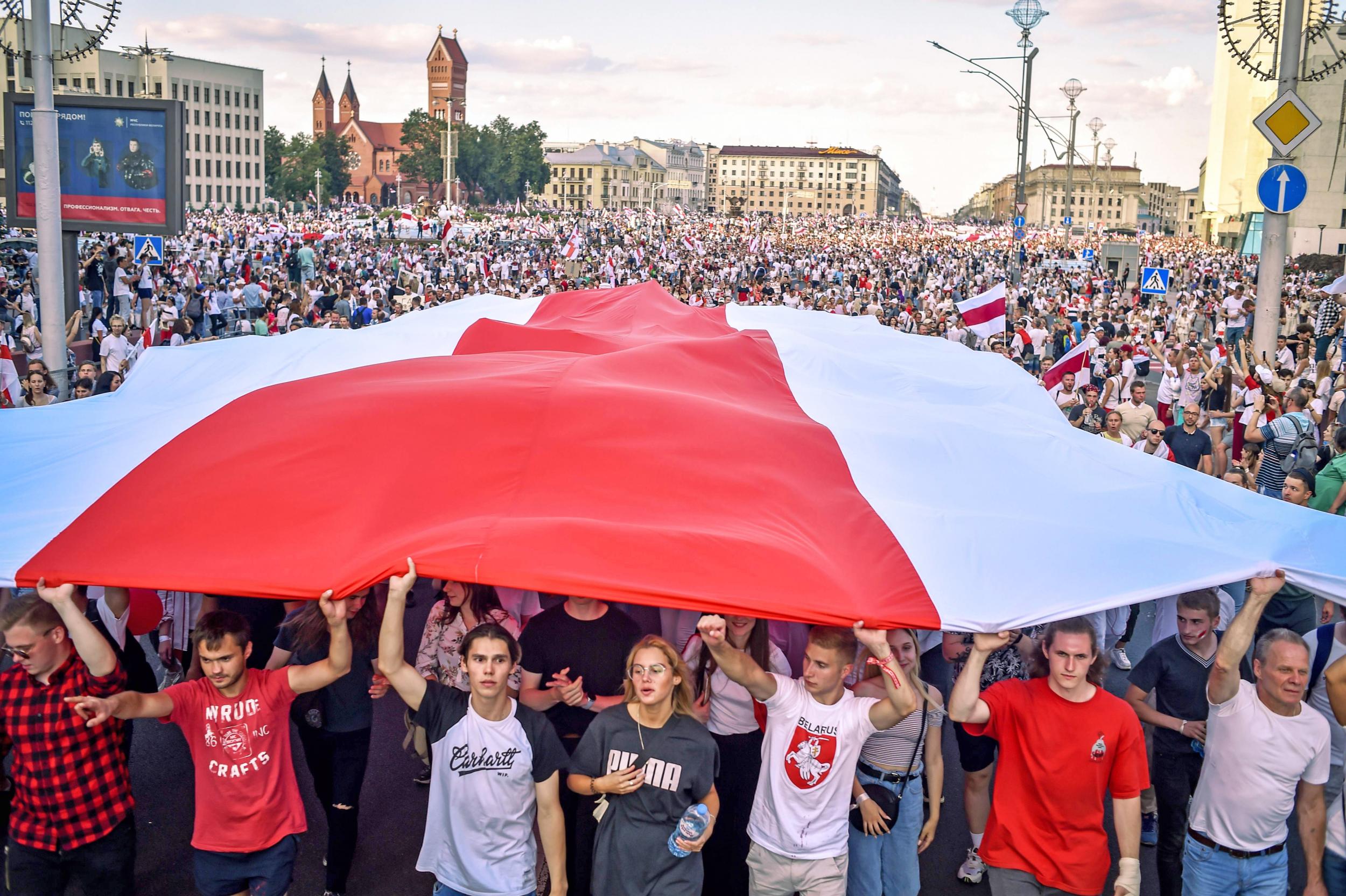After the biggest protests in Belarus’s history, what happens now?
President Lukashenko appeared increasingly desperate last week. But, says Mary Dejevsky, there are signs it could take years before the leader finally goes


This time last week, Belarus looked as though it was in the throes of a popular uprising. Huge crowds thronged the streets of Minsk and other cities, protesting about an election that gave every impression of having been stolen. Within days, factory workers came out on strike in what was starting to resemble a classic, 1917-style revolution.
The supposed victor in the election, Alexander Lukashenko, who has occupied the presidency for 26 years, was looking and sounding increasingly desperate. Restrictions on free assembly and free speech seemed to be in abeyance. The riot police – initially so ruthless – had gone home or changed sides. Parts of Lukashenko’s support system seemed to be cracking. The opposition candidate, Svetlana Tikhanovskaya, who had escaped to neighbouring Lithuania the day after the election, announced a committee to prepare a transition.
Now, Lukashenko appears to be retrenching. He has warned people against returning to the streets (though some have) and factory strikers have been dismissed. Riot police are back (with newly awarded medals and bonuses), and approaches to the state media centre – key to any modern-day revolution – have been blocked. At best, Belarus looks set for a period of political stalemate. At worst, for a new crackdown on dissent.
The question is whether it will be days, weeks, or even years before Lukashenko finally goes? A full decade passed between the brutal suppression of electoral protests of 2010 and the now seemingly premature jubilation on the streets of Belarus last week. Could it be as long again? Forecasting is always risky, but one way or another, I suspect that irreversible change will be coming to Belarus sooner rather than later.
First, this is because Lukashenko has shown a degree of vulnerability that he did not in 2010. Second, it is because, while some argue that Putin needs Lukashenko to stay in power – to discourage those who might harbour revolutionary thoughts in Russia – Putin is no fan of leaders who lose their grip. He accepted the fiercely pro-western candidate, Viktor Yushchenko, who swept to power in an election re-run after Ukraine’s Orange Revolution in 2004-05, and showed little but contempt for his supposedly preferred candidate, Viktor Yanukovych, after he fled Ukrainian people power in 2014. A leader who caves in or who risks being toppled is no use whatsoever to the big power next door.
The third reason is that there are signs, in the way they have treated developments in Belarus so far, that both Russia and the west, specifically the European Union, might actually have learned something from the destructive stand-off over Ukraine. This may be extreme wishful thinking on my part, and the hope could be dashed at any moment, but there would seem to be an effort at least to avoid anything that might escalate the situation in Belarus into a Ukraine-style confrontation between east and west.
The tragedy of Ukraine in 2014 is that in the preceding months there were many forks in the road where another course could have been taken. As it was, everyone concerned made fateful choices that narrowed future options and served to speed up the impending crisis. The immediate subject of contention was an association agreement proposed by the EU, but Ukraine’s decision over whether to sign up became a zero-sum game with much greater geopolitical implications. What happened had to be a win either for the west or for Russia – there could be no middle way.
At the time, Ukraine had a number of ardent champions within the EU, who insisted that Kiev faced a “now or never”, “all or nothing” choice between east and west. There seemed to be no flexibility in the timetable and scant recognition that such a treaty might have negative economic consequences for Russia, let alone be seen as a western power-grab. US enthusiasm for the treaty gave it yet another dimension.
When Moscow persuaded Yanukovych not to sign at the last moment, support for the treaty had already gained a life of its own: not least in the United States, where it was seen as determining Ukraine’s future western orientation, and in Kiev where it was seen as a proof of Ukraine’s European identity and a prelude to EU membership. What followed were bloody clashes on the streets of the Ukrainian capital, the flight of Yanukovych into Russian exile, Russia’s seizure of Crimea, and an armed conflict in southeast Ukraine that has cost thousands of lives and continues to this day. An EU attempt to mediate a peaceful transition from Yanukovych collapsed, apparently scuppered by the US.
Among the consequences of the Ukraine crisis were, for the west, the poisoning of relations with Russia; for Ukraine, loss of territory and a narrowly averted civil war; for the EU, a costly and clumsy diplomatic defeat; and for Putin, on the upside, the gain of Crimea and a surge in domestic popularity, but, on the downside, the long-term loss of Ukraine. It is a balance sheet that is predominantly negative all round.
Now it must also be said that, although they were both part of the former Soviet Union and occupy what would widely be seen as east-west borderlands, Ukraine and Belarus are very different. With more than 40 million people, Ukraine’s population is four times larger than that of Belarus. There is no historic quarrel, as there is between Moscow and Kiev, about the primacy of early statehood or religion. Belarus also lacks the large and assertive diaspora that has given Kiev such pronounced support against Moscow.
That said, however, there was, and is, the potential for many of the elements that went into the Ukraine crisis to be replicated with Belarus. Its strategic significance for Russia was graphically underlined during the Second World War, when – with Ukraine – it bore the brunt of the German advance. For the EU and Nato, any switch of Belarusian allegiance from east to west could be seen as a gain that completes the Soviet demise. So far, though, claims and ambitions along these lines have been little in evidence.
The Belarus opposition has mostly limited its aims to freedom, a new democratic constitution and fresh elections. The protests have been neither anti-Moscow nor pro-EU. When some demonstrators turned up with EU flags, they were told to put them away. As leader, Tikhanovskaya has stressed that she wants good relations with Russia. At its “virtual” summit this week, the EU said it did not recognise the election result and would prepare targeted sanctions against those it held responsible. But it stopped short of withdrawing recognition from Lukashenko as president and proposed to mediate a dialogue between government and opposition.
This time, too, there has been no overt US involvement – whether this is because it is preoccupied with the pandemic and the coming election, or because Belarus simply does not register on Donald Trump’s radar. If Russia has done anything to shore up Lukashenko since the election, it would appear to be mainly in the field of morale-boosting and in private.
Whatever the reasons, the United States, the EU and Russia all seem to be waiting on the sidelines to see what happens next, while loudly calling on each other not to intervene. And the sidelines are where they should stay. To be legitimate and stable, any new leadership in Belarus must have the consent and the support of the people who live there. If that is a lesson learned from Kiev in 2014, perhaps Ukraine’s ordeal – while not yet over – was not entirely in vain.
Join our commenting forum
Join thought-provoking conversations, follow other Independent readers and see their replies
Comments